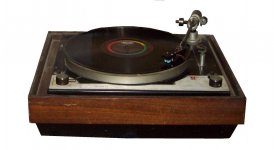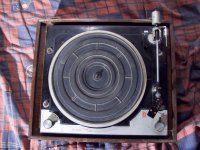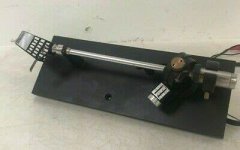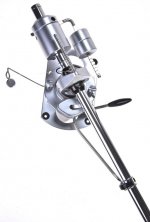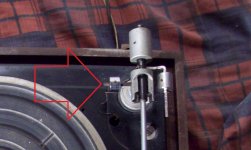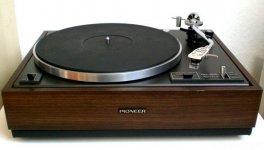I had one of these, made here and very, very sold.
It was highly recommended by DJs in the 70's for its strength,fortress . Pulley traction. There was a little problem that can be seen in the design of the tonearm. Let's see if they discover it, there are no prizes for first place (whoever gets it right first), just the satisfaction of being recognized as an "expert" in TT. 😊
I can't really say that about the author of the Wikipedia article......I would have chosen another photo of a TT to attach to the article ! 👎
https://es.wikipedia.org/wiki/Tocadiscos
There is no English version, but GT will translate it, although it is not necessary, just look at the pictures 😉
It was highly recommended by DJs in the 70's for its strength,fortress . Pulley traction. There was a little problem that can be seen in the design of the tonearm. Let's see if they discover it, there are no prizes for first place (whoever gets it right first), just the satisfaction of being recognized as an "expert" in TT. 😊
I can't really say that about the author of the Wikipedia article......I would have chosen another photo of a TT to attach to the article ! 👎
https://es.wikipedia.org/wiki/Tocadiscos
There is no English version, but GT will translate it, although it is not necessary, just look at the pictures 😉
Attachments
Last edited:
There was a little problem that can be seen in the design of the tonearm. Let's see if they discover it...
Does the arm not have the appropriate vertical pivot angle?
Attachments
I would have chosen another photo of a TT to attach to the article !
So, are we talking about an inherent design fault or has someone tampered with the particular turntable shown in the image?
Yes, we are talking about an inherent design flaw (also unforgivable) .......So, are we talking about an inherent design fault or has someone tampered with the particular turntable shown in the image?
So, you're looking for something else other than vertical pivot angle and I don't win the non-prize?? 💰

Hi wiseold!
I've got you to thank for the vertical pivot angle image! 😎
Are you referring to the adjustable outrider weight on the right hand side of the tonearm?
SME have used a similar arrangement (see attachment).
It's that stubby weight jutting out at right angles on the left hand side of the Sincron arm that is puzzling me. An anti-skating arrangement I'm not familiar with?
I've got you to thank for the vertical pivot angle image! 😎
It's got a goofy stylus pressure adjustment - poor design.
Are you referring to the adjustable outrider weight on the right hand side of the tonearm?
SME have used a similar arrangement (see attachment).
It's that stubby weight jutting out at right angles on the left hand side of the Sincron arm that is puzzling me. An anti-skating arrangement I'm not familiar with?
Attachments
Sorry, I already had this written, I'll read later.
I didn't check for the tracking angle error when I got the Sincron, I just sold it shortly after I bought it new. It was probably not optimal.
The TT had terrible feedback, impossible to use in small rooms, that's why I sold it, (I was a teenager and the dimensions of my bedroom were normal, about 3 x 4 meters) but the main design problem is not that, because it could be used well in large environments. (Club's, dance halls, etc). Simply the fault was not something perceptible that bothered a DJ's or those present in the auditorium ......
The creator of the Sincron was an electromechanical engineer, without deep knowledge about the requirements that a TT arm has to meet.
He simply looked and copied, a little here, a little there, and that monstrosity came out. Yes, it's hard to believe, he sold thousands, that is, he wasn't the only one without minimum knowledge, buyers also fell into the trap, and I began to get confused and fell into it when it was time to calibrate the tone arm.... I seem to remember that the simple manual (brochure) of instructions only said what each piece was for....
Look carefully at the straight arm that this gentleman decided to create and manufacture and assume that you are the designers.
What regulation systems should a straight and cardanic movement arm have for optimal performance?
1 - Weight regulation for balancing
two . Vertical force regulation (VTA)
2 - Regulation of the anti-slip force
3 - Side Balance Compensation (S-arms only)
More impossible help.
I didn't check for the tracking angle error when I got the Sincron, I just sold it shortly after I bought it new. It was probably not optimal.
The TT had terrible feedback, impossible to use in small rooms, that's why I sold it, (I was a teenager and the dimensions of my bedroom were normal, about 3 x 4 meters) but the main design problem is not that, because it could be used well in large environments. (Club's, dance halls, etc). Simply the fault was not something perceptible that bothered a DJ's or those present in the auditorium ......
The creator of the Sincron was an electromechanical engineer, without deep knowledge about the requirements that a TT arm has to meet.
He simply looked and copied, a little here, a little there, and that monstrosity came out. Yes, it's hard to believe, he sold thousands, that is, he wasn't the only one without minimum knowledge, buyers also fell into the trap, and I began to get confused and fell into it when it was time to calibrate the tone arm.... I seem to remember that the simple manual (brochure) of instructions only said what each piece was for....
Look carefully at the straight arm that this gentleman decided to create and manufacture and assume that you are the designers.
What regulation systems should a straight and cardanic movement arm have for optimal performance?
1 - Weight regulation for balancing
two . Vertical force regulation (VTA)
2 - Regulation of the anti-slip force
3 - Side Balance Compensation (S-arms only)
More impossible help.
That's right, make an effort to study the photos, I don't want to give the award to YOUR friend.....So, you're looking for something else other than vertical pivot angle and I don't win the non-prize?? 💰
Good ! The false AS does not work! You are the winner ! 👍🙂It's that stubby weight jutting out at right angles on the left hand side of the Sincron arm that is puzzling me. An anti-skating arrangement I'm not familiar with?
The genius who created this design mistook a lateral balance weight for S-arms with the anti-skate system.
In fact, put it in any position after the static balanced, the arm doesn't even move ...........😳
In other words, an arm without an anti-skating system, but who cares?
Not the DJs, surely.
In fact, put it in any position after the static balanced, the arm doesn't even move ...........😳
In other words, an arm without an anti-skating system, but who cares?
Not the DJs, surely.
Attachments
I anticipate those who want to introduce elements of discord in this thread and argue that the aforementioned weight is to compensate for the weight that regulates the VTA, and thus avoid uneven wear of the tonearm supports in the left and right sector.-
REJECTED ! NOT SUBJECT TO CONSIDERATION !
REJECTED ! NOT SUBJECT TO CONSIDERATION !
Attachments
The genius who created this design mistook a lateral balance weight for S-arms with the anti-skate system.
The Pioneer PL-12D S-shaped tonearm famously had a lateral balance weight (see attachment).
Many users removed it, following the (dubious?) advice of others. Then, when they wanted to replace it, they found they had lost it! 😆
Attachments
Wow!!
Thanks Academia, you made me go back 50 years!
I owned two Sincron in the early 70s, at that time in Argentina you had Sincron or Winco as the only "professional" turntables available.
Thanks Academia, you made me go back 50 years!
I owned two Sincron in the early 70s, at that time in Argentina you had Sincron or Winco as the only "professional" turntables available.
Wow!!
Thanks Academia, you made me go back 50 years!
I owned two Sincron in the early 70s, at that time in Argentina you had Sincron or Winco as the only "professional" turntables available.
Hola ! Si el tango dice que veinte años no es nada, entonces cincuenta es sólo un poquito en el camino de la vida.
( me agarró la nostalgia filosófica ) En efecto, las dos que se hicieron acá, pero Winco copió y bien. Fijate acá, el sistema de cambio de velocidades y eje conico de Lenco ! Y el brazo era una copia de un modelo de Audio Tecnica con el AS modificado. Era otra cosa. Yo pasé de Sincron a la L-75 de Lenco, que también luego vendí, hoy en día pienso que de haberla conservado podria hacer una bandeja audiófila de primer nivel con otro brazo. ( El brazo de Lenco tenía el problema de las cuchillas que descansaban sobre asientos de goma y se gastaban, y el peso de balanceo se vencia porque estaba suspendido con un alambre de acero de desacoplamiento. Pero por esas mismas razones no entraba en resonancia acustica , una maravilla. ) Saludos !
https://articulo.mercadolibre.com.a...cking_id=de3fb1de-7697-4ec5-b213-403be617a004
Hello ! If the tango says that twenty years is nothing, then fifty is just a little bit along the path of life.
(Philosophical nostalgia seized me) Indeed, the two that were made here, but Winco copied and well. Look here, Lenco's gear change and tapered shaft system! And the arm was a copy of an Audio Tecnica model with the modified AS. It was something else. I went from Sincron to Lenco's L-75, which I also later sold, today I think that if I had kept it I could make a first level audiophile tray with another arm. (The Lenco tonearm had the problem of the blades resting on rubber seats and wearing out, and the balance weight giving out because it was suspended with a decoupling steel wire. But for those same reasons it didn't go into acoustic resonance, wonderful.) Greetings!
Attachments
There is nothing doubtful. I don't remember seeing S-tonearms without the counterweight on the left to compensate for the mass on the right (draw a straight line from the pivot to the needle contact point and it's easy to understand)The Pioneer PL-12D S-shaped tonearm famously had a lateral balance weight (see attachment).
Many users removed it, following the (dubious?) advice of others. Then, when they wanted to replace it, they found they had lost it! 😆
Where do I send you the prize ! it's surprise 😉😳
There is nothing doubtful.
I used the word "dubious" with its meaning of "not to be relied upon" or "of questionable value" with regard to advice to remove the lateral balance weight.
It was understood, it must be used yes or yes. That's what they put it in for, right?
And what about the prize, do you want it or not ?
And what about the prize, do you want it or not ?
The lateral balance weight arrangement is there for good reason. I'm not arguing otherwise. I fear my meaning has been lost in translation. 😀
Some so-called 'experts' claimed the lateral balance system of the PL-12D produced unwanted resonances which were detrimental to the reproduction. This persuaded some owners to remove the system. Obviously, I wouldn't be so easily persuaded! 😉
Regarding the prize, it is sufficient to have been honoured on these pages. No physical reward is necessary, but thank you for your kind consideration. 😎
Some so-called 'experts' claimed the lateral balance system of the PL-12D produced unwanted resonances which were detrimental to the reproduction. This persuaded some owners to remove the system. Obviously, I wouldn't be so easily persuaded! 😉
Regarding the prize, it is sufficient to have been honoured on these pages. No physical reward is necessary, but thank you for your kind consideration. 😎
- Home
- Source & Line
- Analogue Source
- The Sincron turntable
